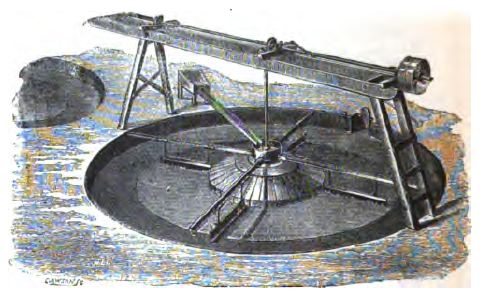Buddle pit on:
[Wikipedia]
[Google]
[Amazon]


 A buddle pit or buddle pond is a pit, often circular when specifically constructed, the purpose of which was to separate by sedimentation minerals from lighter rock dust in crushed
A buddle pit or buddle pond is a pit, often circular when specifically constructed, the purpose of which was to separate by sedimentation minerals from lighter rock dust in crushed

ore
Ore is natural rock or sediment that contains one or more valuable minerals, typically containing metals, that can be mined, treated and sold at a profit.Encyclopædia Britannica. "Ore". Encyclopædia Britannica Online. Retrieved 7 Apr ...
, and used in the mineral mining industry (such as in extracting tin
Tin is a chemical element with the symbol Sn (from la, stannum) and atomic number 50. Tin is a silvery-coloured metal.
Tin is soft enough to be cut with little force and a bar of tin can be bent by hand with little effort. When bent, t ...
, lead
Lead is a chemical element with the symbol Pb (from the Latin ) and atomic number 82. It is a heavy metal that is denser than most common materials. Lead is soft and malleable, and also has a relatively low melting point. When freshly cu ...
and zinc
Zinc is a chemical element with the symbol Zn and atomic number 30. Zinc is a slightly brittle metal at room temperature and has a shiny-greyish appearance when oxidation is removed. It is the first element in group 12 (IIB) of the periodi ...
). Many of the relics seen today date from Victorian times.
Early examples of buddle pits were often natural hollows in the ground, adapted by lining them with stone or clay to make them waterproof.
A purpose-built pit, constructed from stone or brick, cement and mortar, contained water, and a set of brushes, often powered by a water wheel
A water wheel is a machine for converting the energy of flowing or falling water into useful forms of power, often in a watermill. A water wheel consists of a wheel (usually constructed from wood or metal), with a number of blades or bucket ...
, which rotated in the water in order to agitate the mixture, the result of which was that the heavier and denser material - i.e. the ore - tended to collect at the centre of the pit, from where it could be retrieved. The worthless gangue
In mining, gangue () is the commercially worthless material that surrounds, or is closely mixed with, a wanted mineral in an ore deposit. It is thus distinct from overburden, which is the waste rock or materials overlying an ore or mineral body ...
was then disposed of, often by draining.
Usually a set of buddle pits was utilised, with the richer central deposits in the pit being carried to another buddle, where they were treated in the same manner, and so on.
Whilst the round buddle pit was the most common, there was a variation called the concave buddle, which had a concave bottom.''Machinery for Metalliferous Mines: A practical treatise for mining engineers, metallurgists and managers of mines'', by E. Henry Davies, C. Lockwood and son, 1902
The following detailed extract comes from ''Machinery for Metalliferous Mines: A practical treatise for mining engineers, metallurgists and managers of mines'', by E. Henry Davies, C. Lockwood and son, 1902 :
See also
* Buddle pits in Dartmoor * Metal mining *Metal mining in Wales
Mining in Wales provided a significant source of income to the economy of Wales throughout the nineteenth century and early twentieth century. It was key to the Industrial Revolution.
Wales was famous for its coal mining, in the Rhondda Valley, ...
* Adelong Falls Gold Workings (Australia)
References
{{Extractive metallurgy Mining techniques History of mining